Abstract
THE Crabtree effect, that is, the respiratory inhibition induced by glucose and other phosphorylable hexoses on addition to cells, is usually, though not always, related to the presence of a high rate of aerobic glycolysis. Such an effect has been seldom investigated in the resting rat liver, in which condition it has given rise to some questionable data (for review, see Ibsen1). In fact, an eventual inhibition may have been missed because of the limited glycolysis rate of the resting liver, probably due to the low affinity for glucose of its hexokinase2.
Similar content being viewed by others
References
Ibsen, K. H., Cancer Res., 21, 829 (1961).
Di Pietro, D. L., Sharma, C., and Weinhouse, S., Biochem., 1, 455 (1962).
Guidotti, G., Clerici, E., and Bazzano, E., Min. Nucleare, 2, 14 (1958).
Higgins, G. M., and Anderson, R. M., Arch. Path., 12, 186 (1931).
Clerici, E., Guidotti, G., Sambo, G., and Bazzano, E., Proc. Soc. Exp. Biol. Med., 105, 377 (1960)
Packer, L., and Golder, R. H., J. Biol. Chem., 235, 1234 (1960).
Arcos, J. C., Gosch, H. H., and Zickafoose, D., J. Biophys. Biochem. Cytol., 10, 23 (1961).
Author information
Authors and Affiliations
Rights and permissions
About this article
Cite this article
CLERICI, E., CICCARONE, P. Crabtree Effect in the Regenerating Liver of the Rat. Nature 201, 1035–1036 (1964). https://doi.org/10.1038/2011035a0
Issue Date:
DOI: https://doi.org/10.1038/2011035a0
- Springer Nature Limited





